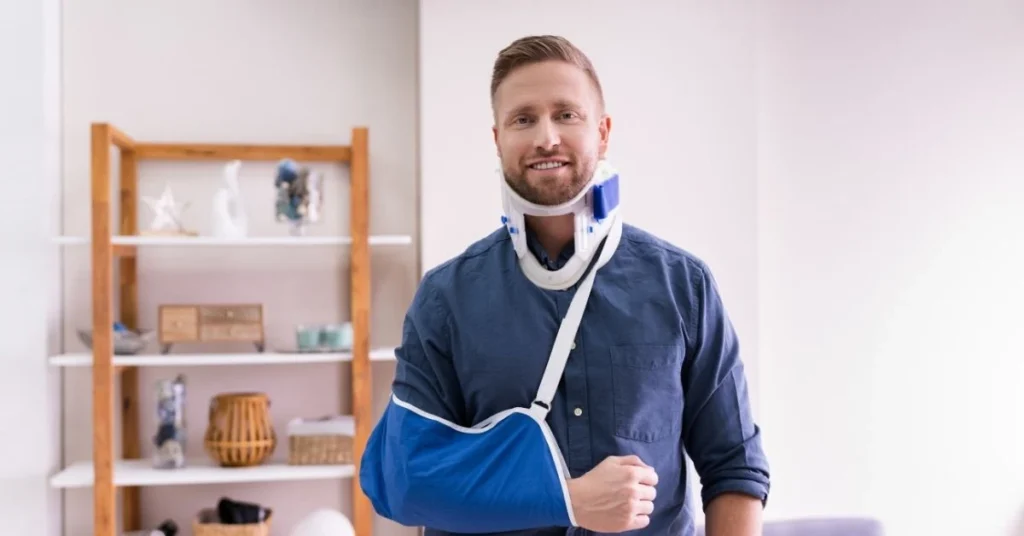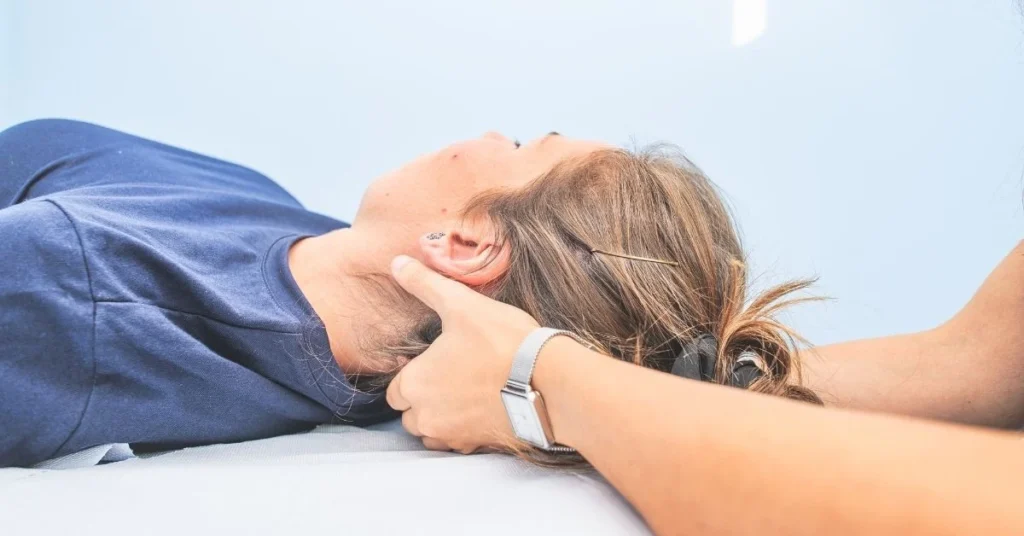A sudden jolt from a car accident or a hard hit during a sports game can leave you with whiplash, a neck injury that causes pain, stiffness, and other challenges. In Dalton, Georgia, where busy roads and active lifestyles are common, whiplash is a frequent concern for many residents.
This guide explains whiplash in detail, covering its causes, symptoms, and how whiplash chiropractic care can help you recover naturally. You’ll find clear information on what to expect during treatment, the science behind chiropractic methods, and practical steps to regain your mobility. The aim is to provide you with the knowledge to understand your injury and make informed choices for your health, without pushing any specific service or provider.
Here’s what this guide will help you understand:
- The mechanics of whiplash, including its causes and how it affects your body.
- How chiropractic care addresses pain and mobility issues without surgery or drugs.
- Specific techniques chiropractors use to treat whiplash, from adjustments to exercises.
- What happens during a chiropractic visit and how long recovery might take.
- Factors to consider when choosing a chiropractor in Dalton for your care.
Understanding Whiplash Injury

Definition and Overview
Whiplash occurs when your neck moves rapidly back and forth, straining the muscles, ligaments, tendons, and nerves in the cervical spine. This injury often stems from car accidents, but sports injuries or falls can also cause it. It affects people of all ages, from children to seniors. If not treated, whiplash can lead to ongoing discomfort or reduced movement. For residents of Dalton, Georgia, a chiropractor for TMJ Dalton Georgia or whiplash specialist can assess whether this natural approach fits your recovery needs, offering a non-invasive path to healing.
History of Whiplash Recognition
The term “whiplash” was first used in the 1920s to describe neck injuries from sudden acceleration-deceleration forces, particularly in car accidents. Early medical literature focused on railroad injuries, but by the mid-20th century, researchers linked whiplash to rear-end collisions. Studies in the 1990s, like those from the Quebec Task Force, established standardized classifications, shaping modern treatment approaches. Today, chiropractors play a key role in managing whiplash, using methods refined over decades to address pain and restore function.
How Whiplash Occurs
Whiplash results from sudden forces that push your neck beyond its normal range. The cervical spine, made of seven vertebrae, supports your head and allows movement. A quick jolt can damage these structures, causing pain, inflammation, and stiffness.
Rapid Back-and-Forth Neck Movement
The defining feature of whiplash is the fast, forceful motion of the head. In a car crash, your head may snap backward then forward in less than a second. This rapid movement, often too quick to brace against, strains neck tissues and increases injury severity.
Impact on Soft Tissues, Ligaments, and Nerves
This motion can tear muscles or ligaments slightly, causing swelling. Discs between vertebrae may bulge or herniate, pressing on nerves. Irritated nerves lead to symptoms like pain, numbness, or limited jaw movement locking TMJ, as the neck and jaw are closely connected. The cervical facet joints, which guide neck motion, may also become inflamed, adding to discomfort.
Anatomy of the Cervical Spine
The anatomy temporomandibular joint and cervical spine are key to understanding whiplash. The cervical spine includes seven vertebrae (C1–C7), connected by ligaments and muscles, with discs cushioning each vertebra. The location structure TMJ, near the jaw, works with the neck to support chewing, speaking, and swallowing. Whiplash disrupts this system, affecting both neck and jaw function, which chiropractors address through targeted care.
Common Causes of Whiplash

Whiplash can happen in various situations, especially in a bustling community like Dalton, Georgia, where daily activities and traffic increase risks.
Car Accidents and Rear-End Collisions
Car accidents, particularly rear-end collisions, are the leading cause of whiplash. Even low-speed impacts can jolt your head, straining neck tissues. In Dalton, roads like Glenwood Avenue see frequent crashes, making early chiropractic care vital to prevent lasting issues from physical trauma injury whiplash jaw impact TMJ.
Sports Injuries and Contact Sports
Athletes in contact sports like football or wrestling face whiplash risks from tackles or collisions. In Dalton, high school sports such as soccer or cheerleading can lead to whiplash if players take sudden hits, especially in competitive games.
Falls and Other Traumas
Falls from bikes, ladders, or during daily tasks can cause whiplash, particularly for children or older adults. Other traumas, like a blow to the head, can also trigger it. These events disrupt neck stability, leading to tissue damage and symptoms like pain or stiffness.
Lifestyle and Occupational Factors
Certain habits increase whiplash risk. Lifestyle factors chewing gum hard foods TMJ or occupational hazards prolonged talking singing TMJ can strain the neck and jaw, making them more vulnerable to injury. For example, teachers or singers in Dalton who talk for long periods may face higher risks if involved in an accident.
Symptoms of Whiplash

Immediate and Delayed Symptoms
Whiplash symptoms can appear right after an injury or take days to show up, which can delay treatment. Recognizing these signs early helps you start recovery sooner. If you notice neck pain, stiffness, or other issues after a trauma, a chiropractor can evaluate whether their care suits your needs, addressing both immediate and long-term effects.
Neck Pain and Stiffness
Neck pain is the most common symptom, ranging from mild to severe. Neck shoulder upper back pain TMJ often comes with stiffness, making it hard to turn your head. Chiropractic adjustments can loosen this stiffness, improving movement.
Headaches and Migraines
Headaches migraines TMJ often start at the skull’s base due to tight muscles or irritated nerves. These can disrupt work, sleep, or daily tasks, but chiropractic care can help by addressing their source.
Shoulder, Upper Back, and Arm Pain
Pain may spread to your shoulders, upper back, or arms, as neck muscles connect to these areas. This can make lifting or reaching uncomfortable, limiting daily activities.
Tingling, Numbness, or Weakness in Arms
Irritated nerves can cause tingling numbness weakness arms, signaling potential nerve involvement. This requires prompt attention to prevent worsening.
Dizziness, Fatigue, and Blurred Vision
Dizziness or imbalance may stem from ear or spine issues. Fatigue and blurred vision can also affect your focus, making daily tasks harder.
Ear-Related Symptoms
Ear pain ringing tinnitus fullness TMJ can occur due to nerve irritation or jaw issues, as the neck and jaw are linked. This can feel like pressure or ringing in the ears.
Jaw and Facial Symptoms
Facial pain swelling TMJ or difficulty chewing swallowing TMJ may arise, as whiplash affects the jaw’s movement. This can make eating or speaking uncomfortable.
Cognitive and Sleep Issues
You might face memory problems, trouble focusing, or irritability from pain or poor sleep. Difficulty chewing swallowing TMJ and neck pain can also disrupt rest, adding to fatigue.
Grading Whiplash Severity
The Quebec Task Force grades whiplash to guide treatment:
- Grade 0: No symptoms.
- Grade 1: Neck pain and stiffness.
- Grade 2: Muscle or joint issues, like tenderness or less movement.
- Grade 3: Nerve issues, like numbness or weakness, needing quick care.
Don’t let whiplash pain control your life. Take the first step towards a pain-free neck today.
Call For Whiplash Relief | Schedule an Appointment
Risk Factors and Complications of Whiplash

Factors Increasing Risk
Previous neck injuries weaken tissues, raising whiplash risk. Older adults have less flexible ligaments, increasing severity. High-speed crashes or poor headrest placement also make injuries worse. Genetic hormonal factors TMJ may play a role, as some people are more prone to joint issues.
Potential Long-Term Complications
Without treatment, whiplash can lead to chronic pain for months or years. This may cause emotional challenges like depression or anxiety, or physical limits like reduced mobility. Early chiropractic care can address misalignments, offering a lasting solution for many by preventing these issues.
Associated Conditions
Whiplash may worsen associated conditions fibromyalgia sleep apnea TMJ. For example, fibromyalgia patients may feel more pain, while sleep apnea can worsen with neck tension. Chiropractors consider these conditions to tailor treatment.
How Chiropractic Care Addresses Whiplash
Principles of Chiropractic Treatment for Whiplash
Chiropractic care focuses on aligning the spine to ease nerve pressure and promote healing. Misaligned vertebrae can worsen whiplash symptoms like neck stiffness from whiplash or pain. Adjustments restore alignment, improving function and reducing discomfort. This approach considers the whole body, addressing related areas like the shoulders or jaw to support recovery.
History of Chiropractic for Whiplash
Chiropractic care for whiplash grew in the late 20th century as car accidents became more common. Early chiropractors used spinal adjustments to treat neck injuries, with techniques evolving to include soft tissue therapies TMJ and rehabilitation. Today, methods like cervical spine manipulation TMJ relief are backed by research, showing their value in whiplash recovery.
Chiropractic vs. Traditional Medicine
Chiropractic care uses hands-on methods, avoiding drugs or surgery. Chiropractic vs traditional treatments TMJ highlights its non-invasive nature, focusing on alignment over medication. Chiropractic vs physical therapy key differences whiplash shows chiropractors prioritize spine and nerve health, while physical therapists focus on muscle strength. Both can work together for better results, with complementary role physical therapy dentistry TMJ enhancing outcomes in complex cases.
When to Combine Treatments
For severe whiplash, like Grade 3, chiropractic care pairs well with physical therapy for muscle support or short-term medication for acute pain. This combined approach ensures a plan that fits your needs, helping you decide if chiropractic suits your recovery.
Benefits of Chiropractic Care for Whiplash

Chiropractic care offers many advantages for whiplash recovery, backed by research and patient experiences, like a Dalton teacher who regained mobility after a rear-end collision.
Natural Pain Relief Without Medication
Adjustments ease nerve pressure and muscle tightness, providing natural pain relief without medication TMJ. Drugs can have side effects or risks of dependency. A 2018 study in The Journal of Orthopedic & Sports Physical Therapy showed chiropractic care reduces neck pain effectively, often with lasting results.
Improved Range of Motion and Mobility
Adjustments and stretches restore joint function, helping you turn your head easily. This aids tasks like driving or working, which limited jaw movement locking TMJ or neck stiffness can hinder. Targeting the cervical spine reduces stiffness for better movement.
Reduced Inflammation and Muscle Tension
Soft tissue therapies TMJ like massage or ultrasound lower swelling and relax muscles. This speeds healing by addressing pain and tissue damage, supporting both short- and long-term recovery.
Faster Recovery and Overall Wellness
Fixing misalignments and swelling speeds recovery. Patients often feel more energy and sleep better as nerves work properly. A Dalton resident, for instance, overcame whiplash from a sports injury and resumed running after weeks of care.
Preventive Care for Chronic Symptoms
Regular adjustments prevent scar tissue and chronic pain, offering a long-term prevention TMJ recurrence when paired with exercises. This can provide a lasting solution, not just temporary relief.
Addressing Associated Issues
Chiropractic care eases headaches migraines TMJ, dizziness, and jaw pain by fixing their causes, like misaligned vertebrae or tense muscles, for complete relief.
Long-Term Benefits
Ongoing care strengthens your neck and spine, reducing symptom recurrence. This is key for active Dalton residents, ensuring a can chiropractic fix TMJ permanently outcome over temporary fixes. Early care can also avoid surgery or long-term drugs, saving costs and reducing risks.
Evidence and Patient Outcomes
A 2020 Spine Journal study found chiropractic care cut pain and improved function in whiplash patients within six weeks. Many avoided chronic issues. In Dalton, patients report similar success, like a construction worker who returned to work pain-free after treatment, showing chiropractic’s lasting impact.
If you’re ready to address whiplash symptoms, consider a consultation with a chiropractor in Dalton, Georgia, like those at Inspine Chiropractic & Wellness, to discuss a personalized recovery plan.
Chiropractic Techniques for Whiplash Treatment

Chiropractors use a range of methods, including adjustments and other therapies, to treat whiplash based on your symptoms and severity.
Spinal Manipulation and Adjustments
High-Velocity, Low-Amplitude (HVLA) Thrust
HVLA adjustments use quick, gentle thrusts to realign vertebrae, easing nerve pressure and boosting mobility. Spinal neck adjustments TMJ are often done on the first visit if safe, starting recovery promptly.
Types of Adjustments
- Techniques diversified Gonstead adjustments TMJ: Diversified uses manual adjustments for broad misalignments, while Gonstead targets specific vertebrae with X-ray precision, ideal for whiplash.
- Cranial manipulation techniques TMJ: These adjust skull and neck connections, easing jaw-related symptoms.
Mobilization Techniques
Gentle Stretching and Joint Mobilization
Gentle TMJ mobilization realignment uses low-force stretches to improve joint movement without fast thrusts. This suits acute whiplash or sensitive patients, supporting recovery gently.
Soft Tissue Therapies
Myofascial Release for Neck Muscles
Myofascial release jaw muscles TMJ loosens tight fascia, reducing pain and improving flexibility, a key non-adjustment therapy.
Active Release Therapy (ART)
Active release therapy ART TMJ combines movement and pressure to break up scar tissue, enhancing muscle function and reducing stiffness.
Trigger Point Therapy
Trigger point therapy TMJ applies pressure to muscle knots, relieving localized pain common in whiplash.
Massage and Soft Tissue Mobilization
Massage soft tissue mobilization TMJ relaxes muscles and boosts blood flow, reducing swelling alongside adjustments.
Don’t let whiplash pain control your life. Take the first step towards a pain-free neck today.
Call For Whiplash Relief | Schedule an Appointment
Additional Supportive Therapies
Flexion-Distraction Technique
This gentle method stretches the spine, easing disc and nerve pressure, especially for herniations.
Instrument-Assisted Soft Tissue Mobilization
Tools like Graston break up scar tissue without manual adjustments, aiding muscle and ligament healing.
Electrical Stimulation and Ultrasound
Cold laser therapy ultrasound TMJ reduces spasms and swelling, speeding tissue repair without invasiveness.
Exercise and Rehabilitation Programs
Exercise rehabilitation programs Rocabado 6×6 TMJ include neck stretches or strengthening to prevent re-injury, supporting recovery without adjustments.
Nutritional Counseling and Lifestyle Guidance
Nutritional counseling stress management TMJ promotes anti-inflammatory diets and stress reduction, aiding healing without adjustments.
What to Expect During a Chiropractic Visit for Whiplash

Initial Consultation and Assessment
Health History Review and Symptom Evaluation
Your chiropractor will review your injury, symptoms, and health history. This helps them decide if chiropractic care fits your whiplash, especially for jaw pain tenderness TMJ or nerve issues. Health history review symptom evaluation TMJ ensures a thorough understanding of your condition.
Physical Exam
They’ll check your neck’s movement, posture, and tenderness. Physical exam jaw range motion posture analysis TMJ identifies misalignments, guiding your treatment.
Diagnostic Tools
Diagnostic tools X-rays thermal scans TMJ like X-rays show spine alignment and inflammation. Starting care within 72 hours of injury can prevent scar tissue and chronic pain, improving outcomes.
Treatment Process
First Adjustment Experience
If safe, a gentle first adjustment experience TMJ may happen on your first visit, easing pain and starting alignment fixes. Worsening symptoms is rare with skilled care, and you might feel relief or mild soreness.
Customized Treatment Plan
A customized treatment plan TMJ outlines visit frequency, techniques, and goals based on your exam. It ensures care matches your recovery needs.
Frequency of Visits and Expected Recovery Timeline
Frequency visits expected timeline TMJ typically involves 2–3 visits weekly for 4–8 weeks for acute whiplash. Mild cases need fewer; severe ones, more. Early care speeds recovery.
Follow-Up Sessions and Progress Monitoring
Follow-up sessions progress monitoring TMJ tracks your improvement, adjusting techniques as needed for steady recovery.
Home Care Recommendations
Home care recommendations jaw exercises ice heat TMJ include avoiding heavy activity before visits and using ice, heat, or stretches afterward to support healing.
Potential Side Effects and Safety Considerations
Common Mild Reactions
Common mild reactions temporary soreness TMJ like slight soreness may occur after adjustments, fading in 24–48 hours. This is normal and not a sign of worsening symptoms.
Rare Risks and When to Seek Immediate Medical Attention
Risks avoid adjustments TMJ are minimal with licensed chiropractors. A 2017 Journal of Manipulative and Physiological Therapeutics study found low adverse event rates. Risks evidence safety TMJ chiropractic care confirms safety, but severe pain, dizziness, or weakness warrants immediate medical attention.
Don’t let whiplash pain control your life. Take the first step towards a pain-free neck today.
Call For Whiplash Relief | Schedule an Appointment
Chiropractic Care for Whiplash in Specific Populations
Whiplash Treatment for Children and Adolescents
TMJ care children adolescents benefits from gentle adjustments and therapies like massage, safe for kids’ growth and recovery from sports or falls.
Chiropractic for Whiplash During Pregnancy
Chiropractic TMJ during pregnancy uses low-force adjustments or therapies like ultrasound, ensuring safety for both mother and baby.
Whiplash Care for Seniors
TMJ treatment adults seniors employs gentle mobilization or therapies like cold laser, accounting for joint stiffness or arthritis, for comfortable recovery.
Whiplash Relief for Athletes
TMJ relief athletes high-stress individuals uses targeted adjustments and rehab to restore performance for Dalton’s active residents.
Myths and Misconceptions About Chiropractic Care for Whiplash

Safety of Chiropractic for Whiplash
Is chiropractic safe TMJ treatment is confirmed by studies like a 2019 Spine report, showing low risks. Proper techniques prevent worsening symptoms.
Pain During Treatment
Does chiropractic treatment hurt jaw is a myth; adjustments are usually painless, with mild soreness fading quickly.
Temporary vs. Lasting Relief
Chiropractors fix TMJ temporary relief is false. With rehab, chiropractic offers lasting relief by addressing misalignments, not just symptoms.
Chiropractic vs. Other Professions
Chiropractic vs dentistry key differences TMJ shows chiropractors focus on spine and nerve health, while dentists address dental structures. What difference chiropractor dentist TMJ clarifies their complementary roles.
Broader Scope of Chiropractic
Common myths debunked chiropractic treats back pain counters the idea that chiropractors only treat backs. They address neck, jaw, and whole-body issues, ideal for whiplash.
Don’t let whiplash pain control your life. Take the first step towards a pain-free neck today.
Call For Whiplash Relief | Schedule an Appointment
Cost of Chiropractic Care for Whiplash in Dalton, Georgia
Average Costs for Visits
How much chiropractic treatment TMJ cost in Dalton ranges from $50–$150 for initial visits, including exams and X-rays, and $30–$80 for follow-ups. This is often cheaper than surgery or drugs.
Factors Influencing Costs
Session length and therapies like cold laser therapy ultrasound TMJ affect costs. Complex cases with multiple therapies may cost more but provide thorough relief.
Insurance Coverage
Will insurance cover chiropractic visits TMJ depends on your plan. Many, including auto insurance for crashes, cover chiropractic care, reducing costs.
Payment Options
Insurance coverage payment options TMJ include payment plans or CareCredit, making care affordable for longer treatment.
Comparing Costs with Other Treatments
Comparing costs other whiplash treatments shows chiropractic care is cost-effective, with fewer side effects than surgery or long-term medication.
For a comprehensive guide on whiplash, TMJ, and back pain treatment, explore our Chiropractic Care Guide For Whiplash, TMJ & Back Pain.
Why Choose Inspine Chiropractic & Wellness

Local Expertise and Community Care
In Dalton, chiropractors like those at Inspine Chiropractic & Wellness, located at 1237 N. Glenwood Ave, understand local needs. Local expertise community-focused care Dalton TMJ ensures care tailored to residents, with 35+ years of team experience. Inspine Chiropractic best choice TMJ Dalton reflects their focus on car accident injuries, helping patients recover fully.
Personalized Treatment Plans
Personalized treatment Dalton residents TMJ means plans designed for your specific symptoms, whether from a crash or sports injury, ensuring effective recovery.
Addressing Local Triggers
Addressing common TMJ triggers Dalton stress lifestyles like busy roads or active sports scenes is key. Chiropractors tackle these with targeted care.
Collaboration with Local Providers
Collaboration local healthcare providers dentists physicians Dalton ensures chiropractors work with doctors and therapists for complete care.
Finding a Qualified Chiropractor
Qualifications credentials TMJ specialization licensing include a Doctor of Chiropractic degree and state license. Experience TMJ conditions chiropractor ensures skill in whiplash or accident injuries. Treatment philosophy patient-centered approach TMJ prioritizes your goals, while questions ask chiropractor TMJ help you choose the right provider. Patient testimonials success stories Dalton TMJ highlight success, like a 5-star review from Christian Kelley praising effective, friendly care.
Local Factors in Dalton
Clinic accessibility location Dalton GA at 1237 N. Glenwood Ave offers easy access with parking and a modern facility. Insurance coverage payment options TMJ make care affordable.
FAQ'S About Whiplash Chiropractic Care
Many patients experience reduced pain and improved mobility within 1 to 4 weeks of starting chiropractic care.
Factors like injury severity and overall health influence timelines, with mild cases showing quicker progress through spinal adjustments and exercises. Severe whiplash may extend recovery to several months, emphasizing consistent sessions for optimal outcomes.
Chiropractic care often leads to lasting relief by restoring spinal alignment and function, particularly in mild to moderate cases.
For severe injuries, ongoing maintenance may prevent symptom return, as underlying issues like disc problems could require periodic attention. Combining adjustments with lifestyle adjustments supports sustained benefits.
Chiropractic care reduces neck pain, stiffness, and inflammation while enhancing range of motion.
Patients frequently report fewer headaches and better daily function through targeted adjustments and therapies. Evidence shows improvements in chronic cases, with many achieving significant symptom relief over time.
Mild whiplash typically requires 6 to 12 sessions over 4 to 8 weeks.
Moderate to severe cases may involve 20 or more visits, starting at 2 to 3 per week and reducing as progress occurs. Personalized plans adjust based on response, ensuring efficient recovery.
Before an adjustment, stay hydrated and avoid strenuous neck activities.
Afterward, rest for 24 to 48 hours, apply ice or heat as advised, and perform gentle prescribed stretches. These practices minimize soreness and support healing by maintaining alignment.
Seek chiropractic evaluation within 24 to 72 hours after injury, assuming no severe symptoms needing emergency care.
Early visits reduce inflammation and prevent chronic issues, with assessments ensuring safe timing for adjustments.
Chiropractors provide soft tissue massage, ultrasound, and electrical stimulation to complement adjustments.
These therapies include:
- Therapeutic exercises for strength and flexibility.
- Heat or cold applications to manage swelling.
- Myofascial release for muscle tension.
Such options enhance overall recovery.
Whiplash patients usually undergo evaluation on the first visit, with adjustments possibly delayed.
Initial sessions focus on exams, history reviews, and imaging to assess safety, starting with gentle therapies if needed before manipulations.












